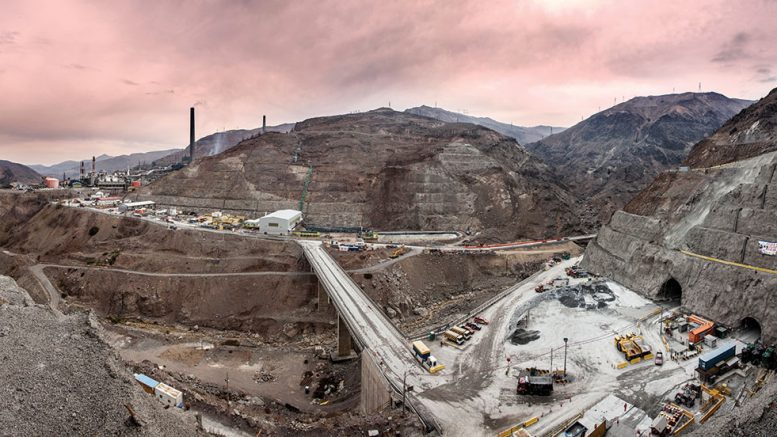U.S. President Donald Trump signed off on a phase-one trade deal with China on Dec. 13 to avert a planned round of tariffs on US$160 billion of consumer goods. The news sent copper rallying to a several-month high of over US$6,170 per tonne (US$2.80 per lb.), and generated renewed optimism for the red metal’s fundamentals heading into 2020.
Consensus forecasts for copper are guardedly bullish heading into next year. Along with most of the base metal suite, copper struggled in 2019 largely due to global trade war concerns and muted global industrial activities that consume the metal. Prices dropped to multi-year lows of US$2.53 per lb. in early September and the metal has not seen US$3 per lb. since mid-2018.
Almost two years of trade war rhetoric between China and the U.S., along with protectionist sanctions levied on multiple international fronts, are flagged as the reasons behind copper’s lacklustre market performance. Slumping industrial growth weighed on global demand, particularly in China, which recently posted multi-year low industrial production growth rates. China represents half of global copper consumption.
Contrary to copper’s weak performance, tightness in physical supply has dropped to decade-plus lows. Global inventories in warehouse stocks have slipped to the 589,000-tonne level, or about nine days of global consumption.
“The biggest boost [for macro copper] might come from the supply side,” Haywood Securities mining analyst Pierre Vaillancourt said in an interview. “Codelco we saw has cut back its investment in development capex to build out its mines, so there’s a risk that Chile may no longer even be the top copper producer. When you look at new projects, the time lines are getting longer. The regulatory issues and social issues especially are impinging on the ability to start up new production. There’s a good underpinning for the metal and for the bigger companies [and] it’s hard to replace production, which is why we see First Quantum now in play.”
Vaillancourt argues that demand will grow. “It’s not going to be, in my estimation, that 2020 is going to take off in terms of demand, but it will hang in there more or less until such time as electric vehicles layer in and start driving it a bit,” he says. “It’s one of those things where, when electric vehicles [EVs] take off, it’s not linearly, it’s logarithmically.”
An increasing global market for EVs is seen as a growth driver for copper consumption as a raw material in the growing technology. According to the Copper Development Association (CDA), whereas conventional cars typically contain 18 to 49 lb. copper, hybrid electric vehicles have 85 lb., plug-in hybrid electric vehicles use 132 lb. and full-battery electric vehicles contain 183 pounds. Forecast growth in consumer EV adoption will also call for support infrastructure — specifically charging ports and stations.
The CDA says that by 2023, annual sales of plug-in EVs should reach over 1 million and account for 7% of annual vehicle sales by 2025. The marketing group also projects that 5 million charging ports would need to support its projected several million EVs on the road by 2025.
On the supply side, global mine output looks poised to modestly increase in 2020. According to the International Copper Study Group (ICSG), after a forecast 0.5% decline in 2019, world mine production looks like it will rise 2% in 2020 to the 21.6-million-tonne level. The 2019 drop owes to disruptions in Africa and declines from two major Indonesian mines. The increase in 2020 factors in an improvement of African and Indonesian output and ramp-up of recently commissioned mines such as First Quantum Minerals’ (TSX: FM) Cobre de Panama operation, which is forecast to add 290,000 tonnes of copper next year.
Producers are poised for relief on processing costs for their copper concentrate output next year. Benchmark smelter treatment charges and refining charges (TC/RC) for 2020 have been pegged at US$62 per tonne/US¢6.2 per lb., the lowest since 2011, and down 23% from US$80.8 per tonne/US¢8.08 per lb. in 2019. The drop indicates a tight market of concentrate supply and rising smelting capacity, particularly in China, where 900,000 tonnes of annual smelting capacity has been added this year, and more is anticipated for 2020.
“Notwithstanding the potential for resurgent demand growth in 2020, copper markets are still likely to see a surplus next year,” Bart Melek, head of commodity strategy at TD Securities, wrote in a recent 2020 commodities outlook note. “We expect that positive mine supply growth of nearly 2% will more than offset demand growth as Chinese consumption underwhelms in the first half of the year. Meanwhile, the U.S.–China trade war will likely linger far beyond 2020 — irrespective of whether a ‘phase-one’ trade deal will be struck.”
Melek is optimistic on copper’s near-term performance, noting that “prices are driven by changes in growth and relative changes in supply-demand balances rather than the outright level of consumption growth.
“Prices will be supported by an inflection point in growth, which could invigorate investor appetite into a potential ‘reflation trade’ — a trade in which the red metal is an industry favourite,” he continued. “Our macroeconomic outlook argues for an improvement by second-half 2020. A restocking cycle will likely take place at the same time as investment appetite takes note of the red metal’s potential to participate in the ‘reflation trade,’ which we expect will drive copper prices notably higher towards $6,375 per tonne (US$2.90 per lb.), in the later part of the year.”
At its recent Focus 2020 presentation held in Toronto, Scotiabank Metals’ strategist Nicky Shiels tabled her year-end short-term outlook for copper, highlighting some of the factors that have weighed on the metal over the past several months and what headwinds it may face in the upcoming year.
The strategist sees trade war potential — despite current positive momentum — as a threat to copper’s macro fundamentals, however buoyancy in recent global manufacturing indexes provides optimism that a potential recession could be dissipating. She also highlighted some of the supply risks facing the metal, specifically civil unrest in Chile and Peru, the world’s number-one and number-two copper-producing countries, and resource nationalism concerns in major copper producers Democratic Republic of the Congo, Zambia, Indonesia and Mongolia.
Optimism in the copper sector has also increased focus on producers, sparking discussion of mergers and acquisitions potential.
Recently, China’s Jiangxi Copper Co. bought 18% of First Quantum, becoming the company’s largest shareholder. Shares in the major copper producer have rallied since Jiangxi acquired its position and have risen over 20% since early December to the $14-per-share level.
At press time copper price traded at US$2.79 per pound.






Be the first to comment on "Trade war pause brightens copper outlook"